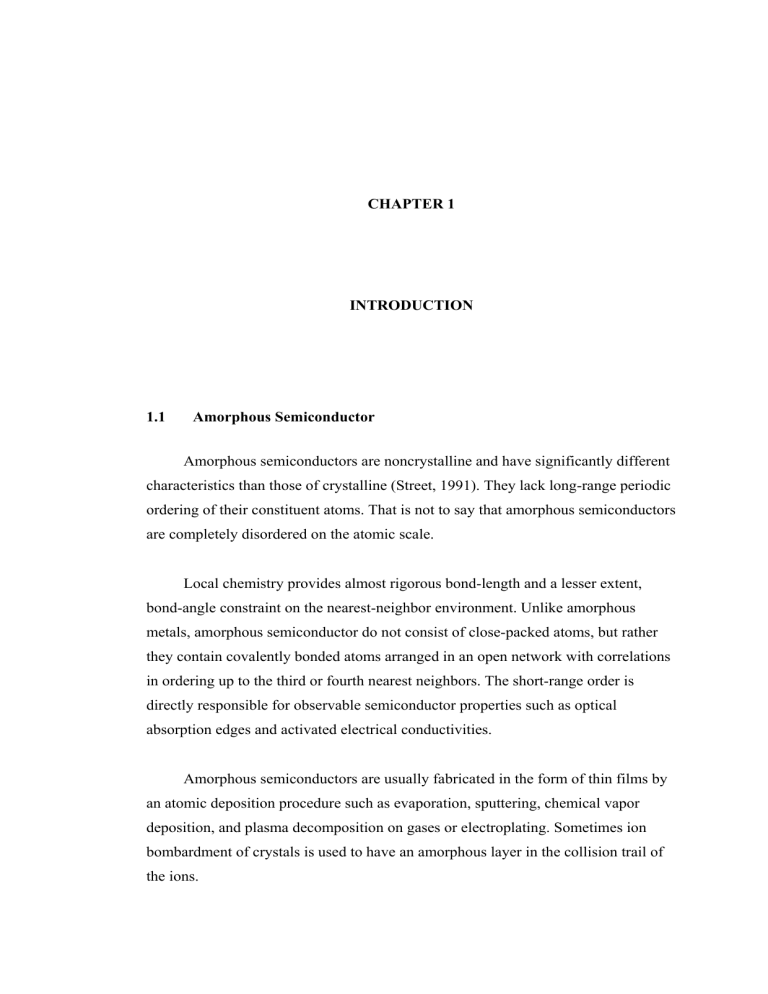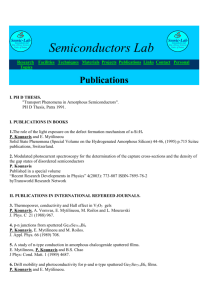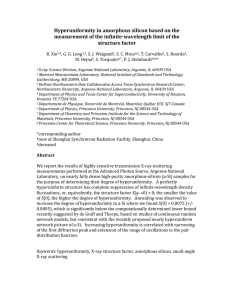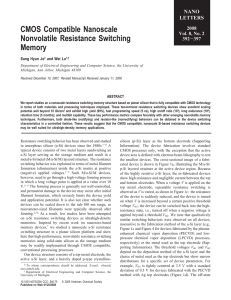Amorphous semiconductors are noncrystalline and have significantly different CHAPTER 1

CHAPTER 1
INTRODUCTION
Amorphous semiconductors are noncrystalline and have significantly different characteristics than those of crystalline (Street, 1991). They lack long-range periodic ordering of their constituent atoms. That is not to say that amorphous semiconductors are completely disordered on the atomic scale.
Local chemistry provides almost rigorous bond-length and a lesser extent, bond-angle constraint on the nearest-neighbor environment. Unlike amorphous metals, amorphous semiconductor do not consist of close-packed atoms, but rather they contain covalently bonded atoms arranged in an open network with correlations in ordering up to the third or fourth nearest neighbors. The short-range order is directly responsible for observable semiconductor properties such as optical absorption edges and activated electrical conductivities.
Amorphous semiconductors are usually fabricated in the form of thin films by an atomic deposition procedure such as evaporation, sputtering, chemical vapor deposition, and plasma decomposition on gases or electroplating. Sometimes ion bombardment of crystals is used to have an amorphous layer in the collision trail of the ions.
2
The commercial potential of amorphous semiconductors has encouraged many to study their properties and preparation. In particular, hydrogenated amorphous silicon (a-Si:H) is very versatile, low cost material that has made it desirable for the use in many device applications. Other special attribute of a-Si:H is the ability to deposit the material inexpensively over large areas.
In recent years, the development of thin film a-Si:H photovoltaic solar cells has been extensively pursued because such devices offer the potential of low-cost electricity, making them attractive as a source of utility and residential electric power. Single-junction a-Si:H p-i-n solar cells with solar energy conversion efficiency of 10% have been achieved by several laboratories (Shen et al.
1991). The basic structure of a single-junction a-Si:H p-i-n cell consists of a very thin (less than
10 nm thick, p-type layer), low-defect, 200 to 600 nm thick intrinsic layer, and a thin
(about 30 nm thick) n-type layer. The construction of a basic single junction thin film a-Si:H solar cell is illustrated in Figure 1.1. To improve efficiency and stability of a-
Si:H solar cells, multiple-junction solar cell structures using a-Si:H alloys are being extensively studied (Yang et al.
1997).
The need for large-area charged particle and X-ray detectors for applications like medical imaging and calorimetry in high-energy physics experiments have stimulated significant investigations into using a-Si:H (50 to 70 µm thick) for such applications (Xi et al.
1991). Other photodiode applications for a-Si:H alloys include ultraviolet light detectors (Krause et al. 2001), edge detector for application to neural network image sensors (Sah et al.
1990), and position sensors for telephone terminals
(Brida et al.
2002).
3
Figure 1.1: Schematic representation of a typical thin film a-Si:H solar cell on glass.
The incoming photons with an energy larger than the band gap are absorbed in the intrinsic a-Si:H film creating holes-electron pairs.
The most attractive applications of a-Si:H technology are active matrix displays and active matrix flat-panel imagers (AMFPIs) (Zhao et al.
1995) which are collectively termed as active matrix arrays (Figure 1.2). Active matrix arrays contain many individual elements commonly known as pixels, which are generally addressed or read out by a grid structure of interconnecting lines termed gate and data lines. In these applications, an a-Si:H thin film transistor (TFT) is used as a switching element or pass transistor. The active matrix arrays require external chips to multiplex and drive the large number of gate and data lines. Considering the growing applications of the active matrix displays and imaging arrays, a low cost on-chip solution is needed for the multiplexer and driver circuitry. Designing of the multiplexer and driver circuits in a-Si:H technology requires the specific details of the displays and imaging arrays.
4
Data line
Gate line
Sensor /
Display pixel
TFT
Figure 1.2: Schematic of a general active matrix array
The unique properties of a-Si:H depend primarily on the complex structure involving different bonding configurations and on the incorporation of hydrogen in the films. Hydrogen, being a terminator in the carbon network, plays a crucial role in determining the properties of the films. The structure of, and the incorporation of hydrogen in a-Si:H films are critically determined by the energy of the ionic species and the consumption of the gas mixture in the deposition process. The ion energy can be changed by varying the deposition parameters. Therefore, it is feasible to obtain a-
Si:H films with a wide range of properties by adjusting the deposition parameters in the growth process.
5
The main purpose of this work is to deposit hydrogenated amorphous silicon
(a-Si:H) thin films using silane (SiH
4
) gas as film precursor via plasma enhanced chemical vapor deposition (PECVD) technique. Secondly, to study the structural characteristics of hydrogenated amorphous silicon (a-Si:H) thin films and to acquire better understanding of this material by characterisation techniques using surface profiler, atomic force microscopy (AFM), UV spectrophotometer, Fourier Transform
Infrared (FTIR) spectroscopy, X-ray diffraction (XRD) and photoluminescence spectrometer. In order to do so, the effect of deposition conditions on the grown film properties is investigated.
Hydrogenated amorphous silicon thin films are deposited using rf-PECVD with silane (SiH
4
) gas as film precursor under different substrate temperature and rf power while other parameters kept constant. The films are then structurally characterized using pre-determined characterization techniques which consist of;
• Surface profiler
• Atomic force microscopy (AFM)
• UV spectrophotometer
• Fourier Transform Infrared (FTIR) spectroscopy
• X-ray diffraction (XRD)
• Photoluminescence spectrometer
1.5 Layout of Thesis
This thesis is organized as follows. In Chapter 1, some of the previous related works on hydrogenated amorphous silicon (a-Si:H) and its application are reviewed.
This chapter also ruled out the objectives of conducting the research.
6
Following the introduction chapter, the literature survey is presented in
Chapter 2. This will cover the growth of a-Si:H thin film process, the fundamental of deposition technique which is the plasma enhanced chemical vapor deposition
(PECVD) and the reaction process in this technique.
Details of experimental methods, including fabrication of the films, PECVD setups are given in the initial part of Chapter 3. This is followed by the characterization techniques used, namely UV spectroscopy, FTIR spectroscopy and photoluminescence.
Chapter 4 presents the results obtained in this work. Among the characterization results that would be presented are the surface morphology and deposition rate, IR transmission spectrum, optical energy gap and photoluminescence. Effect of varying deposition parameters on the film characteristics will also be discussed in this chapter.
Finally, the conclusions of the project are made in Chapter 5. These include the summarization of the whole project and some recommendations for future work are also suggested.






